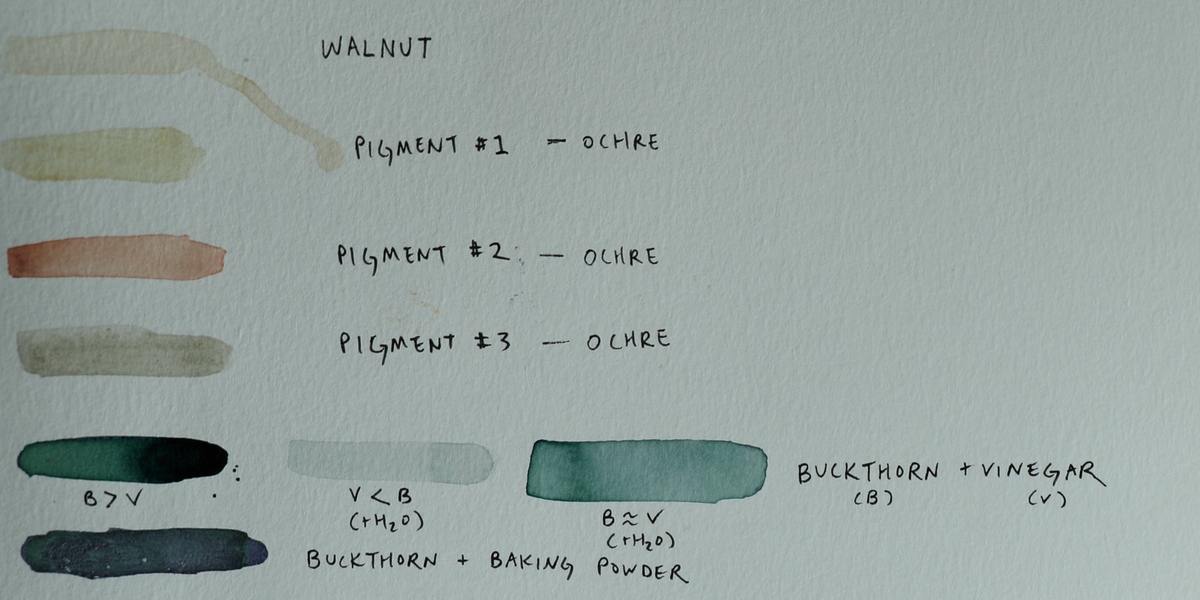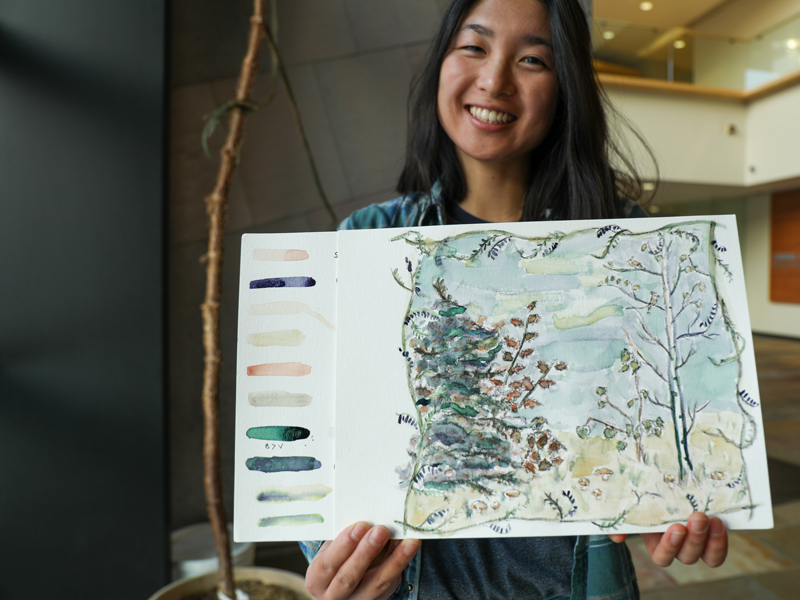
On the cover: trees (from left to right): Jack pine (Pinus banksiana), northern red oak (Quercus rubra), American basswood (Tilia americana), paper birch (Betula papyrifera); mushrooms: Amanita sp. birds: Cedar waxwing (Bombycilla cedrorum); border: Hairy vetch (Vicia villosa)
Maria Park spends her days studying tree communities. The Ecology, Evolution and Behavior Ph.D. student is a keep observer of nature who turns those observations into insights about how trees influence one another. Her love of nature and penchant for looking closely at the world around her started early and fed a lifelong interest in both science and art. Park, who is a trained artist and serves as a teaching assistant for the University’s Art and Ecology course in addition to her work in the Cavender-Bares lab, produced the art for the college’s year-end card. She used natural pigments to create a scene featuring species found in the Forests and Biodiversity experiment at Cedar Creek Ecosystem Science Reserve, where Maria investigates how tree community composition influences the growth and stress of trees.
Can you say a bit about your area of study and how you got involved?
I have always been curious about how the natural world works. I love exploring outdoors, and am fascinated by the complexity and beauty of the diverse lifeforms that inhabit Earth. We, humans, are so deeply interconnected with our non-human neighbors. Knowing this, and realizing how severely we are impacting the world’s ecosystems motivates me to better understand and steward the ecological systems we are part of.
I am currently a Ph.D. student in the Ecology, Evolution, and Behavior program at UMN, as part of the Cavender-Bares Lab. I study how plants grow and interact with each other in the context of forest communities (plant ecophysiology). I am interested in how tree community composition affects resource availability, stress, and growth of individual trees. Essentially, I am working to understand how trees influence other trees in their neighborhood by altering the local availability of light, water, and nutrients. I hope that this work can someday help inform conservation, restoration, and sustainable use of our forest ecosystems.
When and how did you first get interested in art? What appeals to you about it?
I have been drawing ever since I could hold a pencil in my hand, and playing music since I could plunk notes on a piano. Art has always been a way for me to observe, interpret, and learn about nature. I have found art to be a language that can transcend borders, cultural differences, and political leanings. Art, in all its forms, can bring joy and pain, grief and enlightenment. Art helps people make sense of the world around us, and connect with each other. Now is an exciting time to be making art, as the definitions and boundaries of art are being shattered and expanded upon. I find myself at the intersections of visual and auditory media, community engagement, activism, and all-around experimentation. I do not desire to be constrained by disciplines. Art is a practice that enables me to weave together the many facets of who I am, giving me the freedom to connect and learn from everyone around me.
How do art and science intersect for you?
As a child, I would doodle dogs, deer, flowers, cardinals, and bluejays. As a college student in biology labs, I would sketch labeled diagrams for organisms including plants, birds, and marine invertebrates.
As a college student in art classes, I would both paint and carry out social experiments with the trees I was researching. As a post-graduate fellow in the Seychelles island archipelago, I did marine conservation (corals! turtles! tortoises!). I also collaborated with Seychellois artists, listening to stories of local Seychellois to understand and document how climate change and other factors are changing their environments, cultures, and societies. In return for the stories, we created personalized paintings and photographs for our interviewees. This collaboration was exhibited in the Seychelles Biennale of Contemporary Arts 2022.
As a Ph.D. student, I collaborate with art professor Christine Baeumler, forestry professor Rebecca Montgomery, and other members of the academic and local communities to practice socially engaged art. We aim to bring awareness of how climate change and human disturbances are changing ecosystems, and build a collective understanding of how we can best steward our local landscapes and waterscapes. Recently, I have been experimenting with making pigments and painting with foraged natural ingredients. I thank artist Kimberly Boustead for bringing me into this realm of artistic, ecological, and chemical experimentation!
What’s your favorite thing to draw and/or paint?
I have a watercolor journal that I bring with me when I go explore new places. When I arrive at a place that calls to me, I will plop down or stand wherever is most convenient, and do a quick plein air painting of my surroundings. There are typically people traveling with me, so I try not to make them wait too long for my painting session. This time pressure forces me to focus, be truly in the moment, in the place, in time. I do love when curious people, oftentimes children, come up to me and ask what I am doing! The act of painting in public opens the door for fun, spontaneous human connection, sometimes communicated in non-English languages. In the end, the paintings capture what I find to be interesting – my observations and interpretations of a place. These paintings are my way of documenting life experiences and fleeting moments as a visual memory.

Maria’s website/more info about the process behind making the card
Artist Kimberly Boustead’s website